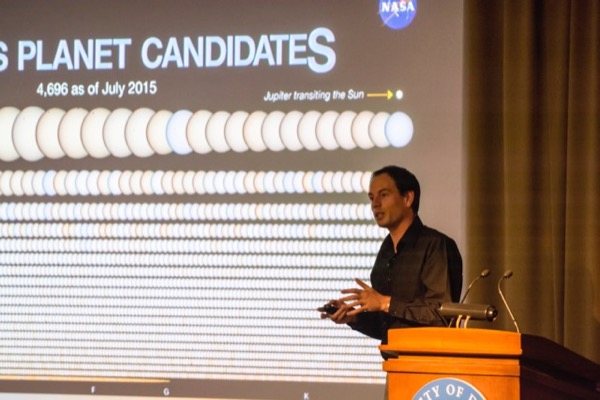


Vernon Lecture
NASA Kepler scientist speaks on question of whether Earthlings are alone in the universe
3:49 p.m., Oct. 16, 2015--Earth is a “pale blue dot” in space, as the famous NASA photo shows. But with an estimated 100 billion galaxies in the universe, each containing some 100 billion stars, there is uncertainty about whether Earthlings are really alone in the cosmos.
That’s the tantalizing question NASA’s Kepler Space Telescope Mission is focused on answering. At the Harcourt C. (Ace) Vernon Memorial lecture at the University of Delaware on Oct. 14, Fergal Mullally, a scientist with NASA’s Ames Research Center and the SETI Institute, shared some of the secrets Kepler is teasing out of the heavens.
Campus Stories
From graduates, faculty
Doctoral hooding
Speaking with an Irish lilt to an audience of about 300, Mullally wove together elements of Carl Sagan, Peggy Lee, baseball, fanciful posters of planets not yet seen, a James Bond movie, and several well-placed scientific graphs to explain what Kepler is searching for and what it’s uncovering.
To home in on good candidate planets where life may exist, you have to know what you’re looking for. Mullally listed four minimum requirements for life:
- Liquid water;
- Rocks (to provide essential minerals, from calcium to lithium);
- Oxygen (although some bacteria do not require oxygen, including those inhabiting smelly shoes, the rest of us couldn’t survive without it); and
- Sunlight (although some marine organisms at hydrothermal vents survive without sunlight, everything you eat is either a plant that lived on sunlight or an animal that ate plants).
He also jokingly listed a fifth requirement: Starbucks.
Planets where these minimum life requirements might exist would be planets like our own, but what does “like our own” mean?
If a planet is too close to a parent star, it will be too hot — any water will boil off and evaporate into space. If a planet is too far from its star: you’ll have ice.
Size is a factor, too, because that influences the gravitational pull a planet has on its parent star and vice versa, affecting how a planet spins to the length of a day. Astronomers have arrived at a rule of thumb that habitable planets should be within, plus or minus, 25 percent the size of Earth, Mullally said.
So a “Goldilocks planet,” where life can exist, has to meet the four minimum requirements for life and also be not too big, not too small, not too hot and not too cold. But how do you find it?
That’s where the Kepler Space Telescope comes in. Weighing about a ton and compact enough to fit on the Clayton Hall stage, the telescope has a mirror 1.4 meters across and a camera made up of 42 2.25-megapixel imagers. It takes about a half-hour to photograph a star. At high-speed mode, a picture can be taken every minute. It’s less sophisticated than some of NASA’s space sleuthing tools — its designer even calls it boring, Mullally said, and cost $600 million to build. “As wars go, it’s not a lot,” he said.
Kepler looks at about 150,000 stars at a time. Hold your hand up to the nighttime sky between the constellation Cygnus the Swan and the bright star Vega, and you’ll get a sense of its field of view.
You might think finding planets should be easy, but Kepler’s challenge is similar to what baseball players face when a flyball is hit on a sunny day and the fielder can’t see the ball because it’s lost in the glare of the sun.
“We have the same problem with planets and stars,” Mullally said. “We only see the light from the star and not from the planet.”
Kepler finds planets through the transit method — by searching for the shadow cast by the planet as it passes in front of a star, which causes a small dip in light.
Light curves — graphs of light intensity — provide scientists with an amazing amount of information. From the size of the dip, you can deduce the size of the planet. From the distance between the dips, you can calculate the distance between star and planet. The surface temperature of the planet also can be determined.
Despite striking artistic representations of exoplanets, they are just that, representations. “This is all we see, all we know,” Mullally said of the data.
However, imaging planets directly is not impossible. “We are the first generation in the history of mankind to see a planet outside our solar system,” Mullally said, noting that the Gemini Planet Imager in Chile recently photographed a young Jupiter-like planet outside our solar system, cloaked in methane and named 51 Eridani b. “But in terms of finding Earth-size planets, we’re getting there.”
Kepler has identified about 4,700 planet candidates. Kepler-10, for example, has a period of 45.29 days, meaning it goes around its star twice in the time Mercury goes around the sun. Part of a two-planet system, it’s a rocky planet, but you wouldn’t want to live there — its surface is pure lava.
“This is the closest you’ll get a serious scientist to discuss hell,” Mullally said.
The big result from Kepler so far, Mullally said, is that “we are now confident that there are more planets than stars in our galaxy,” a finding that has been submitted for publication in a scientific journal.
Additionally, a statistical study on how many planets are like Earth concluded that a number as low as 2 percent and as high as 25 percent could be plausible.
“Let’s say it’s 2 percent,” Mullally said. “About 1 million of the 100 billion stars in our galaxy are like the sun. So there are at least 20,000 planets like Earth in our galaxy. So these Earth clones, planets like are own, are nearby, 200 to 300 light years away.”
But is anyone else living there? One of the big challenges will be communicating with other life in the universe, if it exists.
“Since the 1936 Olympics, we’ve been putting out signals,” Mullally said during the question and answer session at the conclusion of his talk. The opening ceremony of the 1936 Olympics was the first major television signal at a frequency high enough to transmit out of Earth’s atmosphere. “So those messages from 80 years ago should now be received from nearby stars. Hopefully, people on those planets enjoyed the Olympics, and do not like the Nazis.”
NASA has new telescopes lined up to bolster the planet search, including TESS, the James Webb Telescope, WFIRST-AFTA and New Worlds.
Just how long does Mullally think it will be before we find another Earth?
“Technologically, it will take 30 years to get those measurements,” he told the audience, ranging from seventh graders to senior citizens. “People in this room will still be alive when that question is answered.”
Individuals can access the Kepler data and help NASA look for planets. A variety of citizen science opportunities are available at planethunters.org.
Article by Tracey Bryant
Photos by Doug Baker









